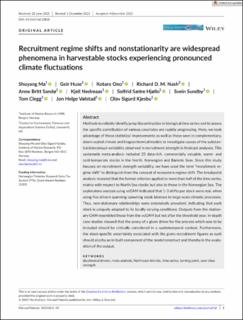| dc.contributor.author | Ma, Shuyang | |
| dc.contributor.author | Huse, Geir | |
| dc.contributor.author | Ono, Kotaro | |
| dc.contributor.author | Nash, Richard David Marriott | |
| dc.contributor.author | Sandø, Anne Britt | |
| dc.contributor.author | Nedreaas, Kjell Harald | |
| dc.contributor.author | Hjøllo, Solfrid Sætre | |
| dc.contributor.author | Sundby, Svein | |
| dc.contributor.author | Clegg, Thomas L | |
| dc.contributor.author | Vølstad, Jon Helge | |
| dc.contributor.author | Kjesbu, Olav Sigurd | |
| dc.date.accessioned | 2024-01-26T09:46:28Z | |
| dc.date.available | 2024-01-26T09:46:28Z | |
| dc.date.created | 2024-01-10T11:51:03Z | |
| dc.date.issued | 2023 | |
| dc.identifier.citation | Fish and Fisheries. 2023, . | |
| dc.identifier.issn | 1467-2960 | |
| dc.identifier.uri | https://hdl.handle.net/11250/3114048 | |
| dc.description.abstract | Methods to reliably identify jump discontinuities in biological time series and to assess the specific contribution of various covariates are rapidly progressing. Here, we took advantage of these statistical improvements as well as those seen in complementary, down-scaled climate and biogeochemical models to investigate causes of the substantial interannual variability observed in recruitment strength in hindcast analyses. This systematic meta-analysis included 23 data-rich, commercially valuable, warm- and cold-temperate stocks in the North, Norwegian and Barents Seas. Since this study focuses on recruitment strength variability, we have used the term “recruitment regime shift” to distinguish from the concept of ecosystem regime shift. The breakpoint analysis revealed that the former criterion applied to more than half of the time series, mainly with respect to North Sea stocks but also to those in the Norwegian Sea. The exploratory analysis using vcGAM indicated that 1–3 shifts per stock were real, when using five drivers spanning spawning stock biomass to large-scale climatic processes. Thus, non-stationary relationships were extensively prevalent, indicating that each stock is uniquely adapted to its locally varying conditions. Outputs from the stationary GAM resembled those from the vcGAM but not after the threshold year. In-depth case studies showed that the proxy of a given driver for the process which was to be included should be critically considered in a spatiotemporal context. Furthermore, the stock-specific uncertainty associated with the given recruitment figures as such should also be an in-built component of the model construct and thereby in the evaluation of the output. | |
| dc.description.abstract | Recruitment regime shifts and nonstationarity are widespread phenomena in harvestable stocks experiencing pronounced climate fluctuations | |
| dc.language.iso | eng | |
| dc.title | Recruitment regime shifts and nonstationarity are widespread phenomena in harvestable stocks experiencing pronounced climate fluctuations | |
| dc.title.alternative | Recruitment regime shifts and nonstationarity are widespread phenomena in harvestable stocks experiencing pronounced climate fluctuations | |
| dc.type | Peer reviewed | |
| dc.type | Journal article | |
| dc.description.version | publishedVersion | |
| dc.source.pagenumber | 29 | |
| dc.source.journal | Fish and Fisheries | |
| dc.identifier.doi | 10.1111/faf.12810 | |
| dc.identifier.cristin | 2223803 | |
| dc.relation.project | Havforskningsinstituttet: 15205 | |
| cristin.ispublished | true | |
| cristin.fulltext | original | |
| cristin.qualitycode | 2 | |
